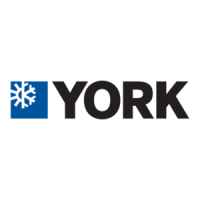123JOHNSON CONTROLS
FORM NO.: 6U6K-B01E-NB-EN
TROUBLESHOOTING (CONT’D)
TABLE 41 - TROUBLESHOOTING (CONT’D)
PROBLEM CAUSE SOLUTION
“High Discharge Press ure
or Compressor Overloa d”
Fault
7. Compressor internal motor protector
(MP) open.
8. External overload tripped.
9. Defective high p ressure cutout switch.
10.Defective CR relay.
7. Veri fy refrigerant charge is not low.
Verify superheat setting (3-5°C).
Verify correct compressor rotation.
Verify compressor is not over loaded.
8. Determine cause and reset.
9. Replace switch.
10.Replace relay.
“Low Liquid Leaving
Temp”
Fault
1.
Improperly adjusted leaving chilled
liquid temp. cutout (glycol only).
2.
Micro panel setpoint/range values
improperly programmed.
3.
Chilled liquid flow too low.
4.
Defective LWT or RWT sensor (as- sure
the sensor is properly installed in the
bottom of the well with a generous
amount of heat conductive compound).
1. Re-program the leaving chilledliquid
temp. cutout.
2. Re-adjust setpoint/range.
3. Increase chilled liquid flow - refer
to limitations in installation section.
4. Compare sensor against a known
good temperature sensing de vice.
Compressor(s) Won’t
Start
1. Demand not great enough.
2. Defective water temperaturesensor.
3. Contactor/Overload failure.
4. Driver failure (for inverter compressor).
5. Compressor failure.
1.
No Probl em. Consult “Installation”
Manual to a id in un derstanding
compressor operati on and capacity
control.
2.
Compare the display with a
thermometer. Should be within +/- 2
degrees. Refer to service section for
RWT/ LWT temp./voltage table.
3.
Replace defective part.
4.
Check driver running status and the
flicker of LEDs.
5.
Diagnose cause of failure and
replace.
Fan Protect 1. Power or communication loss.
2. Internal fa n fault.
1. Check the wiring;
2. Contract local service for further fa ult
analysis.
Lack of Coolin g or
Heating Effect
1. Fouled evapo rator surface (in cooling
mode). Low suction pressure will be
observed.
2. Fouled coil surface (in heati
ng mode).
Low suction pressure will be observed.
3. Improper flow through the evaporator.
4. Low refrigerant charge. Low suction
pressure will beobserved.
1.
Contact the local Johnson
Controls representative.
2.
Contact the local Johnson
Controls representative.
3.
Reduce flow to within chiller design
specs. See limitations in Installation
section.
4.
Check subc ooling and add charge as
needed.
SECTION 10 – SERVICE AND TROUBLESHOOTING
Cooke Industries - Phone: +64 9 579 2185 Email: sales@cookeindustries.co.nz Web: www.cookeindustries.co.nz

